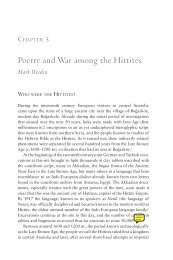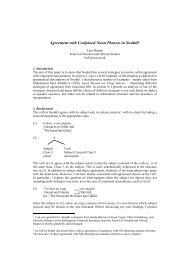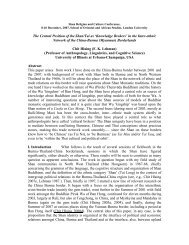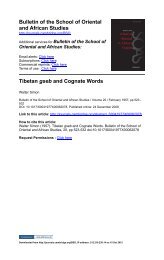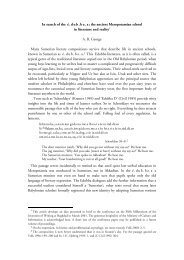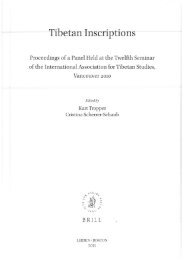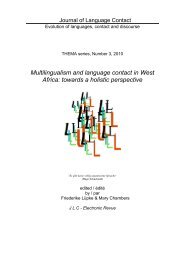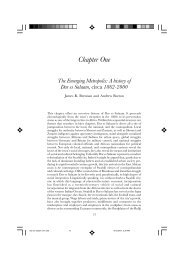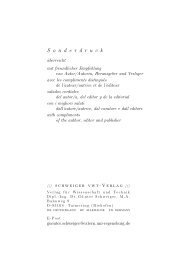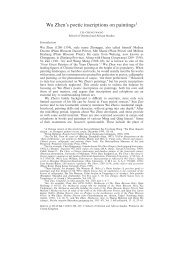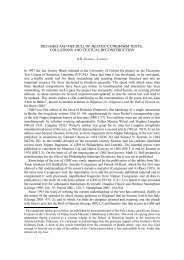Literarische Stoffe - The School of Oriental and African Studies
Literarische Stoffe - The School of Oriental and African Studies
Literarische Stoffe - The School of Oriental and African Studies
Create successful ePaper yourself
Turn your PDF publications into a flip-book with our unique Google optimized e-Paper software.
116<br />
7. <strong>The</strong> Avestan solar year<br />
Almut Hintze<br />
According to the model proposed here, the Avestan year was organized in such a way that there<br />
were seven summer months <strong>of</strong> 30 days <strong>and</strong> Ÿve winter months <strong>of</strong> 29 followed by the ten days<br />
<strong>of</strong> the Fravashi festival. <strong>The</strong> principle <strong>of</strong> bridging the gap between the lunar <strong>and</strong> solar years by<br />
means <strong>of</strong> a special ritual time has a parallel in Vedic culture where a ceremony lasting for twelve<br />
days (dv¡da›¡há-) is performed during the period between the years. 53 <strong>The</strong> annual insertion <strong>of</strong><br />
twelve days at the end <strong>of</strong> the lunar year was an alternative to the periodic intercalation <strong>of</strong> a<br />
thirteenth month (adhim¡sa-), which later became the prevalent method. 54 <strong>The</strong> dv¡da›¡háritual<br />
extends over a ten-day period (da›¡há-) <strong>and</strong> two atir¡trá-, the Ÿrst <strong>and</strong> twelfth days. 55<br />
<strong>The</strong> ten days are further subdivided into three three-day sections (trir¡trá-) followed by the<br />
tenth, agniÞomas¡man-day. 56 According to the account <strong>of</strong> the origin <strong>of</strong> the dv¡da›¡há- ritual<br />
given in Aitareya Br¡hma÷a IV 24–25, the twelve-day ceremony was the oldest <strong>and</strong> best <strong>of</strong> all<br />
sacriŸces. It was Ÿrst performed by the seasons <strong>and</strong> months at the request <strong>of</strong> Praj¡pati, who<br />
represents the year, but subsequently the roles were reversed <strong>and</strong> Praj¡pati performed it for the<br />
seasons <strong>and</strong> months. As a result, the months <strong>and</strong> seasons, <strong>and</strong> with them the year, became<br />
Ÿrmly established. 57 However, because <strong>of</strong> the annual insertion <strong>of</strong> extra ritual days outside the<br />
months, the latter were not always in agreement with the moon phases, <strong>and</strong> both the Ved. <strong>and</strong><br />
53 Falk 2002, 77. <strong>The</strong> noun dv¡da›¡há- (i.e. dv¡da›a-ahá-) is a dvigu compound denoting a run <strong>of</strong> twelve days<br />
which constitute one unit, see Wackernagel (& Debrunner) II 1, 305. Attestations <strong>of</strong> dv¡da›¡ha- in Vedic<br />
Prose <strong>and</strong> later are listed by Mylius 1995, 19 <strong>and</strong> 80.<br />
54 Zimmer 1879, 360, 366; Hillebr<strong>and</strong>t 1897, 5f.; Ginzel 1906–1914, 314. According to Weber 1859, 388<br />
<strong>and</strong> 1885, 224f. the practice <strong>of</strong> inserting additional days at the end <strong>of</strong> the lunar year is an Indo-European<br />
inheritance which is also continued in the Germanic “twelve nights”. <strong>The</strong> latter in turn are reminiscent <strong>of</strong> the<br />
twelve months <strong>of</strong> the year. This emerges, for instance, from TS 5.6.7, which enjoins that consecration should<br />
be for twelve nights, because there are twelve months in a year. According to PB X.3.11, the year culminates<br />
in the dv¡da›¡há- ritual: ‘<strong>The</strong>se days, forsooth, are the force <strong>and</strong> strength in the year: the twelve full-moondays,<br />
the twelve ek¡Þak¡s, the twelve new-moon-days. <strong>The</strong> whole force <strong>and</strong> strength that is in the year he<br />
reaches <strong>and</strong> obtains by this twelve-day-rite’ (translation by Cal<strong>and</strong> 1931, 233). Haudry 1983, 31 <strong>and</strong> 1988,<br />
230f. adduces evidence for the Twelve Days from Vedic, Germanic <strong>and</strong> Greek traditions. According to him,<br />
the twelve-day sleep <strong>of</strong> the Vedic Rbhus at Ágohya corresponds to the twelve-day feast <strong>of</strong> the Elves in Germanic<br />
mythology. Cf. also Nilsson 1920, 22. Thibaut 1899, 9f., however, rejects the idea <strong>of</strong> annual extra days<br />
outside the months on the grounds that there is no Vedic evidence either for the solar year or for the<br />
importance <strong>of</strong> the 12 nights at the end <strong>of</strong> the lunar year, but these objections are unjustiŸed.<br />
55 Renou 1954, 79.<br />
56 PB X.5.17, translated by Cal<strong>and</strong> 1931, 239. <strong>The</strong> ten days <strong>of</strong> this rite are described in great detail in<br />
Pañcavi¿›a Br¡hma÷a X–XV, translated by Cal<strong>and</strong> 1931, 228–425.<br />
57 AB IV 24–25, see Aufrecht 1879, 112f., Keith 1920, 214f. <strong>and</strong> the summary by Gonda 1984, 83. AV<br />
4.11.11 states that the ‘twelve nights’ (dv¢da›a r¢trayas) are dedicated to Praj¢pati, the major deity <strong>of</strong> the<br />
dv¡da›¡há- ritual.



